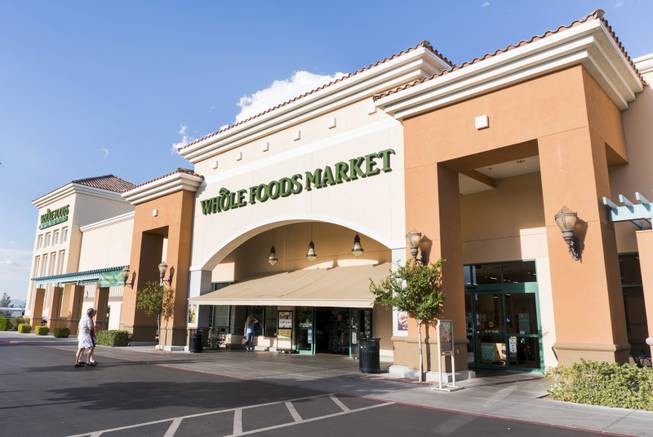Tuesday, Aug. 29, 2017 | 2 a.m.
Las Vegas Valley shoppers seeking organic foods at reasonable prices may be able to reduce their number of grocery stops soon.
On Monday, its first day after completing its $13.7 billion purchase of Whole Foods, Amazon slashed prices on select items throughout the stores.
At the Green Valley Parkway location in Henderson, orange tags were affixed to meats, produce and other items to indicate price reductions. Fresh tilapia and salmon were $2 cheaper per pound than the day before, and rib-eye steak dropped $3 per pound.
“There are certain things that only Whole Foods has, so that’s what I come here for,” Henderson resident Judy Watson said. “Trader Joe’s is usually my favorite because you can always count on the prices to always be consistent. Here you have to be a little more picky and look because you don’t know.”
With some prices already lowered, Amazon promised more changes but wouldn’t divulge details.
“As a mom, I would love to not have to shop at five different places,” Watson said. “It’s exciting, and I would definitely shop here more.”
There are four Whole Foods locations in the valley. While Whole Foods has been successful, one of the main deterrents from people shopping at the organic grocer is its reputation for high prices.
“My boyfriend doesn’t like to come to Whole Foods because of the stigma that’s it’s really expensive,” Henderson resident Dinnia Digennaro said. “I don’t mind paying a little extra more because I felt like the quality of the product is better. As long as the quality of the food doesn’t go down, I will continue to shop here.”
Local price changes
Avocados, from $1.99 to $1.49
Tilapia, from $9.99 per pound to $7.99 per pound
Atlantic salmon, from $12.99 per pound to $9.99 per pound
Gallon of organic milk, from $6.59 to $5.99
Ground beef, from $5.99 per pound to $4.99 per pound
Rib eye steak, from $16.99 per pound to $13.99 per pound
Whole chicken, from $3.49 per pound to $2.99 per pound
What will change
Whole Foods had been just starting to test a loyalty program. But soon, shoppers at all stores will be able to tap Amazon's $99-a-year Prime program to get discounts at stores. And they will eventually be able to buy some Whole Foods products from Amazon.com. Lockers will be added in some locations so Amazon shoppers can pick up e-commerce orders or return items they don't want.
Those who watch the industry expect Amazon to push further into grocery deliveries, among other things. Whole Foods stores can serve as new distribution points for the AmazonFresh delivery service, allowing Amazon to expand where it offers home deliveries. That could include an expansion of ready-to-cook meal packages it's been testing in selected markets, including Seattle.
What the deal means
The deal gives Amazon more than 465 physical stores in the U.S., Canada and the U.K. Before the acquisition, Amazon had a small brick-and-mortar presence with less than a dozen bookstores, a prototype convenience store in Seattle and pickup locations in some cities near college campuses. The new relationship may also give the Seattle-based company valuable data on how people shop in stores, where the vast majority of retail sales still take place.
Amazon is an expert in using data on past purchases and browsing to offer suggestions that might make people buy more, and could start applying that in stores as well as online.
Whole Foods, meanwhile, gets to exhale. Before the deal, the chain was under intense pressure from shareholders to improve its financial results and figure out how to stop customers from going to lower-priced supermarkets to buy natural foods. Whole Foods CEO John Mackey, who will stay in that role, said Amazon's history of innovation could transform Whole Foods from “the class dunce” to “valedictorian.”
What it means for the competition
Shares of supermarkets took a hit when the deal was announced in June, and again when Amazon said last week that it planned to cut prices at Whole Foods.
Rivals are scrambling to keep up: Kroger is testing online grocery delivery in several cities. And Walmart, the nation’s largest grocer, is expanding its online grocery ordering and store-curb pickup to more stores. Last week, Walmart said it is joining forces with Google to let customers order goods with their voice on Google-run smartphones and other devices.
But despite the price drops, Whole Foods may still be pricier than the competition. At a Philadelphia Trader Joe’s, a dozen extra-large organic eggs were selling for $3.69 on Monday, 30 cents lower than large organic eggs at a Whole Foods store less than a mile away.
How the deal went through
Despite Amazon’s dominance online, Walmart remains the leading retailer overall, with more than three times Amazon's retail revenue. A union that represents food-industry workers had asked the Federal Trade Commission to examine the deal carefully, saying it could hurt competition, but the U.S. regulator didn't see it that way.
The FTC said last week that it conducted an investigation to see if the acquisition lessened competition and “decided not to pursue” the matter. Typically, deals that bring two direct competitors together raise flags with regulators, but Amazon — despite its online dominance — doesn’t currently have a big groceries business.
The Associated Press contributed to this report.


Join the Discussion:
Check this out for a full explanation of our conversion to the LiveFyre commenting system and instructions on how to sign up for an account.
Full comments policy